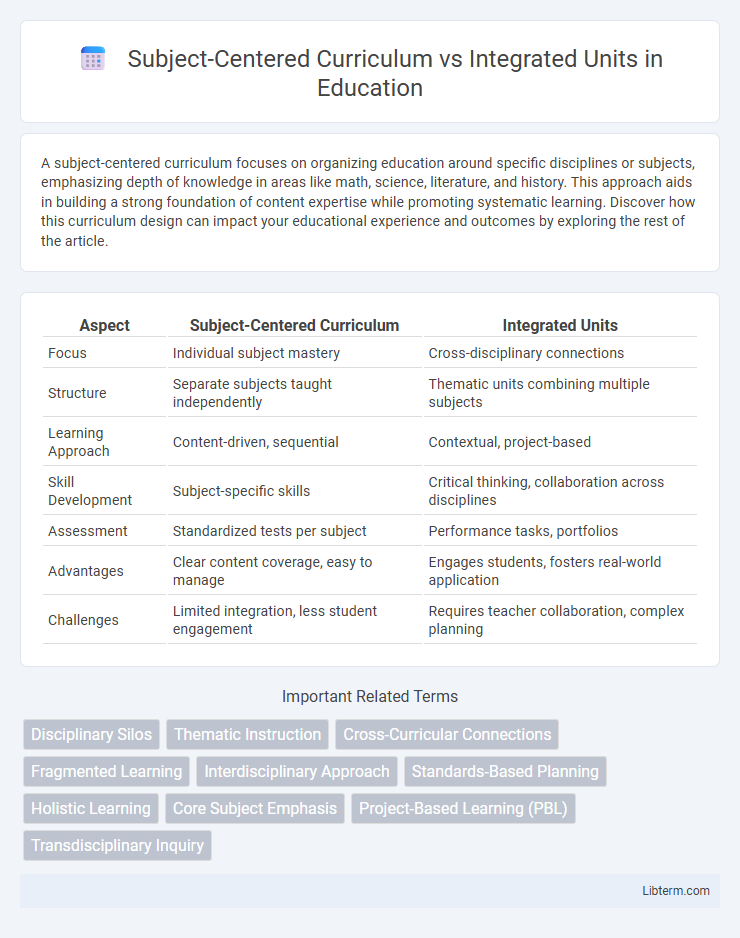A subject-centered curriculum focuses on organizing education around specific disciplines or subjects, emphasizing depth of knowledge in areas like math, science, literature, and history. This approach aids in building a strong foundation of content expertise while promoting systematic learning. Discover how this curriculum design can impact your educational experience and outcomes by exploring the rest of the article.
Table of Comparison
| Aspect | Subject-Centered Curriculum | Integrated Units |
|---|---|---|
| Focus | Individual subject mastery | Cross-disciplinary connections |
| Structure | Separate subjects taught independently | Thematic units combining multiple subjects |
| Learning Approach | Content-driven, sequential | Contextual, project-based |
| Skill Development | Subject-specific skills | Critical thinking, collaboration across disciplines |
| Assessment | Standardized tests per subject | Performance tasks, portfolios |
| Advantages | Clear content coverage, easy to manage | Engages students, fosters real-world application |
| Challenges | Limited integration, less student engagement | Requires teacher collaboration, complex planning |
Understanding Subject-Centered Curriculum
Subject-centered curriculum emphasizes teaching distinct academic disciplines separately, focusing on in-depth knowledge and mastery within specific subjects such as mathematics, science, or history. It structures learning around clearly defined subject areas to develop expertise and maintain academic rigor. Understanding this approach highlights its role in promoting specialized skills and systematic knowledge acquisition, contrasting with the cross-disciplinary nature of integrated units.
Key Features of Integrated Units
Integrated units emphasize thematic connections across multiple subjects, promoting interdisciplinary learning by linking concepts from math, science, language arts, and social studies within a unified framework. This approach fosters critical thinking and real-world problem-solving skills by encouraging students to explore topics in depth through diverse perspectives and activities. Curriculum design in integrated units supports collaboration among teachers and aligns learning objectives to ensure coherence and relevance across disciplines.
Historical Context and Educational Shifts
The Subject-Centered Curriculum emerged during the early 20th century, emphasizing discipline-specific knowledge aligned with industrial-era educational goals, while Integrated Units gained prominence in the late 20th century as part of progressive education movements advocating interdisciplinary learning to enhance critical thinking and real-world application. Historical shifts, including the move from rote memorization to constructivist approaches, influenced the transition towards Integrated Units that connect multiple subjects around common themes or problems. Educational reforms such as the Common Core State Standards further support Integrated Units by promoting cross-curricular skills and deeper understanding.
Core Advantages of Subject-Centered Approaches
Subject-centered curriculum offers a structured framework that emphasizes in-depth mastery of individual disciplines, promoting specialized expertise and foundational knowledge critical for academic progression. It facilitates targeted assessment and curriculum alignment with standardized educational benchmarks, ensuring consistent learning outcomes across diverse student populations. This approach supports clear teacher accountability and resource allocation, enhancing instructional effectiveness within subject areas.
Benefits of Integrated Unit Models
Integrated unit models enhance student engagement by connecting multiple subject areas through thematic learning, fostering deeper understanding and retention of knowledge. These models support the development of critical thinking and problem-solving skills by encouraging students to make interdisciplinary connections and apply concepts in real-world contexts. Educators benefit from streamlined planning and assessment processes aligned with holistic learning outcomes, improving instructional efficiency and student achievement.
Challenges in Implementing Subject-Centered Curriculum
Implementing a Subject-Centered Curriculum faces challenges such as student disengagement due to fragmented learning experiences that lack real-world connections. Teachers often struggle with rigid content boundaries, limiting interdisciplinary teaching and adaptive learning strategies. Resource allocation and teacher training demand increase as educators must master specific subject content while ensuring student comprehension across diverse topics.
Obstacles to Successful Integrated Learning
Integrated units often face obstacles such as curriculum fragmentation, where the lack of subject-specific depth hinders mastery of core concepts compared to subject-centered curricula. Teachers may struggle with inadequate training and resources to effectively blend disciplines, leading to inconsistent instructional quality. Time constraints and standardized testing pressures further restrict opportunities for seamless interdisciplinary integration, limiting the potential for holistic student understanding.
Student Engagement and Learning Outcomes
Subject-centered curriculum promotes deep knowledge acquisition by focusing on specific disciplines, but may lead to fragmented learning and decreased student engagement due to lack of context. Integrated units connect multiple subjects around common themes, enhancing student engagement through real-world relevance and fostering critical thinking and problem-solving skills. Research shows integrated approaches often improve learning outcomes by supporting knowledge transfer and increasing motivation.
Assessment Methods: Subject-Centered vs Integrated
Subject-centered curriculum assessments typically involve standardized tests or quizzes that evaluate discrete knowledge in specific subjects, emphasizing individual subject mastery. Integrated units use performance-based assessments such as projects, presentations, or portfolios that measure students' ability to synthesize and apply knowledge across multiple disciplines. This approach prioritizes holistic understanding and real-world problem-solving skills over isolated subject recall.
Choosing the Best Approach for Diverse Classrooms
Selecting between a subject-centered curriculum and integrated units depends on classroom diversity and learning goals. Subject-centered curricula offer depth in specific disciplines, beneficial for students needing structured skill development, while integrated units foster interdisciplinary connections and accommodate varied learning styles. Tailoring the approach to students' cultural backgrounds, interests, and cognitive levels maximizes engagement and academic achievement in diverse educational settings.
Subject-Centered Curriculum Infographic

 libterm.com
libterm.com